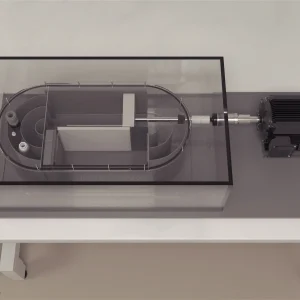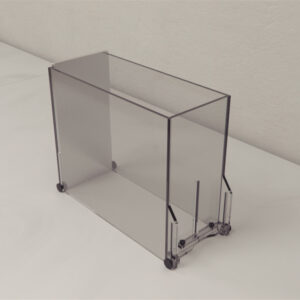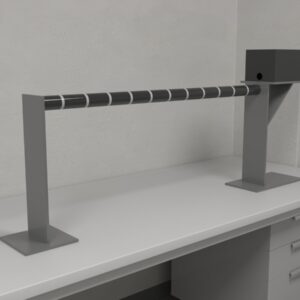$1,800.00 – $1,900.00Price range: $1,800.00 through $1,900.00
The rodent tilt ladder was originally described in the literature in 1989 in physiologic saphenous vein experiments, where rodents were kept in a tilt state. The tilt ladder can additionally be used in many other motor function experiments as it is combined with a ladder like grounding and moved to any angle needed to obtain a reward.

MazeEngineers empowers preclinical neuroscience research with meticulously designed, customizable behavioral apparatuses. From manual classic mazes to fully automated smart systems, we provide the tools scientists need to capture high-quality, reproducible data for studies on learning, memory, anxiety, and depression.

bool(false)


bool(false)
Mouse |
60 cm in length |
40 ladder rungs |
Bar Length: 10 cm to accommodate 8 cm width of ladder. |
Bar Diameter: 0.3 cm |
Drilled holes in regularly spaced 1cm intervals allowing for multiple patterns of bar insertion. |
Bar location: 1 cm above the base of the wall |
Internal Height: 5cm |
Rat |
65 cm in length |
45 ladder rungs |
Bar Length: 15 cm to accommodate 13 cm width of ladder. |
Bar Diameter: 0.3 cm |
Drilled holes in regularly spaced 1cm intervals allowing for multiple patterns of bar insertion. |
Bar location: 1 cm above the base of the wall |
Internal Height: 6cm |

The Tilt Ladder was introduced by Monos and colleagues in their 1989 study, which explored the long-term effects of tilt on the rat saphenous vein. Originally designed to investigate how static loads contribute to chronic adaptations in the vascular system, the Tilt Ladder’s design facilitates easy access to the animals, which is beneficial for procedures requiring catheter insertion for pressure measurements.
In addition to its initial purpose, the Tilt Ladder can be employed to evaluate motor function by subjecting animals to varying inclinations. The apparatus features a tube-like runway that confines the animal, preventing it from turning around once inside. This setup compels the animal to move in a single direction along the ladder, with the inclines adding a gravitational component to the challenge. Given the restraint imposed by the apparatus, it is essential to provide rest periods for the animal’s well-being.
Other devices for assessing motor function and grip include the Horizontal Ladder, Stairway Test, Balance Beam, and Rotarod.
The Tilt Ladder is made from transparent acrylic and features a tube-like structure with a length of 65 cm and an internal height of 6 cm. It includes 45 removable rungs, each measuring 13 cm in length and 0.3 cm in diameter. The rung placement holes are spaced 1 cm apart, enabling various configurations of bar arrangements. One end of the ladder is mounted on a pivot point, allowing for adjustments in inclination from 0 to 90 degrees, while the other end is fitted with a dispenser for food and water.
Before and after each experiment, clean the Tilt Ladder to avoid any residual stimuli that could impact the subject’s performance. Position the apparatus on a level surface and ensure it is well-lit. For tracking and recording, use a system like Noldus Ethovision XT.
Adjust the Tilt Ladder to the desired incline and secure it in place. Place the subject at the pivoted end, ensuring it is oriented head-up and facing the elevated end. Block the entryway to keep the subject from escaping. Make sure to provide adequate food and water at the elevated end. Subjects can remain in the apparatus for the duration of the experiment, but it is advisable to allow them at least one hour of rest per trial or day. During this rest period, place them in a spacious cage where they can move freely and groom themselves to maintain their well-being.
Investigation of vein wall response to chronic pressure
Sprague-Dawley rats underwent increased hindlimb venous pressure using the chronic tilt method with the Tilt Ladder set at a 45-degree angle. Each rat was individually placed in this setup for two weeks, with unrestricted access to food and water at the elevated end. A control group of Sprague-Dawley rats was maintained in the same setup but without any inclination, serving as restricted controls. Additionally, a separate group of free-moving Sprague-Dawley rats kept in standard cages without any tilt acted as non-restricted controls for comparison.
After the two-week period, segments of the saphenous vein were removed and cannulated to assess changes in mechanical properties. Results indicated that in the tilted rats, internal venous pressure increased to 20 mmHg (from 0 mmHg), leading to an average external diameter of 772 ± 34 µm, compared to 567 ± 24 µm in the non-tilted controls. Despite this, chronic tilt treatment did not alter the vessel wall thickness at zero pressure or its response to increasing intraluminal pressure. Notably, a significant rise in mean tangential wall stress was observed at 20 mmHg in both tilted and restricted rats. (Monos, Contney, Cowley Jr., & Stekiel, 1989)
The following observations are made using the Tilt Ladder,
The Tilt Ladder provides a non-invasive alternative to surgical methods for applying static loads. Compared to other ladder-based systems and load-induction techniques, it is relatively less stressful for the animals. Additionally, the apparatus is useful for evaluating motor skills and locomotion. Its design facilitates easy access to the animals, which simplifies procedures like connecting venous and arterial catheters to transducers for pressure measurements. The Tilt Ladder offers the flexibility to adjust the incline from 0 to 90 degrees and includes a built-in food and water dispenser. This feature helps maintain the subjects’ well-being and minimizes stress during extended periods in the apparatus.
The Tilt Ladder restricts the subject’s movement to some extent, which could impact their stress levels. To ensure the subject’s well-being, it is crucial to provide rest periods both during and between trials. Performance may be influenced by the subject’s weight, so having a large group of subjects with similar weights is important for obtaining consistent results. Additionally, factors such as age and sex can affect performance, as can the subject’s emotional and mental state.
Monos, E., Contney, S. J., Cowley, A. W. Jr., & Stekiel, W. J. (1989). Effect of long-term tilt on mechanical and electrical properties of rat saphenous vein. American Journal of Physiology-Heart and Circulatory Physiology, 256(4), H1185–H1191. doi:10.1152/ajpheart.1989.256.4.h1185
| Species | Mouse, Rat |
|---|
There are no questions yet. Be the first to ask a question about this product.